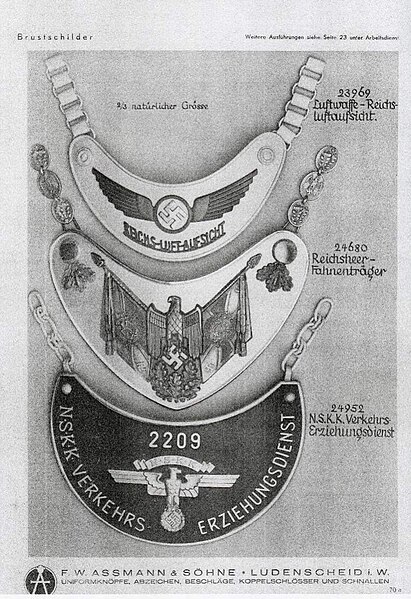File:F.W. Assmann & Söhne Lüdenscheid Nazi Germany 1930s catalog BRUSTSCHILDER (gorgets) LUFTWAFFE Reichs-Luft-Aufsicht REICHSHEER Fahnentrager NSKK Verkehrs-Erziehungsdienst Nazi insignia propaganda No known copyright CC BY-SA img657 -.jpg

Original file (791 × 1,152 pixels, file size: 171 KB, MIME type: image/jpeg)
Captions
Captions
Summary edit
| DescriptionF.W. Assmann & Söhne Lüdenscheid Nazi Germany 1930s catalog BRUSTSCHILDER (gorgets) LUFTWAFFE Reichs-Luft-Aufsicht REICHSHEER Fahnentrager NSKK Verkehrs-Erziehungsdienst Nazi insignia propaganda No known copyright CC BY-SA img657 -.jpg |
English: Page from a product catalog published in the 1930s by F.W. Assmann & Söhne, Lüdenscheid i. W.. Assmann was a factory producing buttons, orders, insignia, badges, fittings, buckles etc (German: Uniformknöpfe, Orden, Abzeichen, Beschläge, Koppelschlösser und Schnallen) as uniform accessories for various organizations in Nazi Germany.
|
| Date | 1930s |
| Source | https://www.warrelics.eu/forum/heer-luftwaffe-kriegsmarine-uniforms-third-reich/heer-standard-bearers-gorget-406420-2/ |
| Author | Product catalog published by the former Firma F. W. Assmann & Söhne in Lüdenscheid, Germany in the 1930s. No known copyright restrictions. |
| Other versions |
|
Licensing edit
- You are free:
- to share – to copy, distribute and transmit the work
- to remix – to adapt the work
- Under the following conditions:
- attribution – You must give appropriate credit, provide a link to the license, and indicate if changes were made. You may do so in any reasonable manner, but not in any way that suggests the licensor endorses you or your use.
- share alike – If you remix, transform, or build upon the material, you must distribute your contributions under the same or compatible license as the original.

|
Legal disclaimer This image shows (or resembles) a symbol that was used by the National Socialist (NSDAP/Nazi) government of Germany or an organization closely associated to it, or another party which has been banned by the Federal Constitutional Court of Germany. The use of insignia of organizations that have been banned in Germany (like the Nazi swastika or the arrow cross) may also be illegal in Austria, Hungary, Poland, Czech Republic, France, Brazil, Israel, Ukraine, Russia and other countries, depending on context. In Germany, the applicable law is paragraph 86a of the criminal code (StGB), in Poland – Art. 256 of the criminal code (Dz.U. 1997 nr 88 poz. 553). |
File history
Click on a date/time to view the file as it appeared at that time.
| Date/Time | Thumbnail | Dimensions | User | Comment | |
|---|---|---|---|---|---|
| current | 23:26, 10 June 2023 |  | 791 × 1,152 (171 KB) | Wolfmann (talk | contribs) | Uploaded a work by Product catalog published by the former [https://www.infantry-assault-badge.com/f-w-assmann-und-soehne-luedenscheid/ Firma F. W. Assmann & Söhne] in Lüdenscheid, Germany in the 1930s. No known copyright restrictions. from https://www.warrelics.eu/forum/heer-luftwaffe-kriegsmarine-uniforms-third-reich/heer-standard-bearers-gorget-406420-2/ with UploadWizard |
You cannot overwrite this file.
File usage on Commons
The following 3 pages use this file:
- File:Abzeichen für Fahnen- und Standartenträger Wehrmacht Heer Brustschild Ringkragen Nazi Germany army flag-bearer gorget insignia Wehrmachtsadler eagle-and-swastika Uniformtafel Detail from 1930s poster.jpg
- File:F.W. Assmann & Söhne Lüdenscheid 098 Uniformköpfe Abzeichen. catalog Nazi Germany 1930s Ringkragen Brustschild LUFTWAFFE Reichsluftaufsicht REICHSHEER Fahnenträger NSKK Verkehrs-Erziehungsdienst. No known copyright. CC BY-SA.jpg
- File:F.W. Assmann & Söhne Lüdenscheid Nazi Germany 1930s catalog BRUSTSCHILDER (gorgets) LUFTWAFFE Reichs-Luft-Aufsicht REICHSHEER Fahnentrager NSKK Verkehrs-Erziehungsdienst Nazi insignia propaganda No known copyright CC BY-SA img657 -.jpg
Metadata
This file contains additional information such as Exif metadata which may have been added by the digital camera, scanner, or software program used to create or digitize it. If the file has been modified from its original state, some details such as the timestamp may not fully reflect those of the original file. The timestamp is only as accurate as the clock in the camera, and it may be completely wrong.
| JPEG file comment | CREATOR: gd-jpeg v1.0 (using IJG JPEG v62), quality = 65 |
|---|

